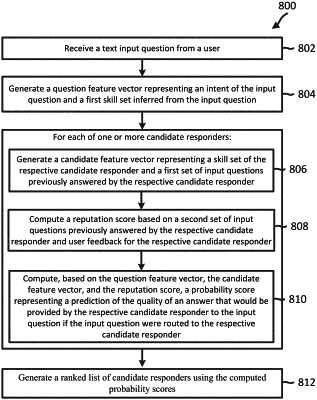| CPC G06F 16/90332 (2019.01) [G06F 9/453 (2018.02); G06F 40/295 (2020.01); G06F 40/30 (2020.01)] | 18 Claims |

|
1. A computing device comprising:
a memory containing machine readable medium storing machine executable code; and
one or more processors coupled to the memory and configurable to execute the machine executable code to cause the one or more processors to:
receive a text input question from a user;
generate a question feature vector representing an intent of the text input question and a first skill set inferred from the text input question;
for each of one or more candidate responders:
generate a candidate feature vector representing a skill set of a respective candidate responder, a first set of input questions previously answered by the respective candidate responder, and metadata profile information provided by the respective candidate responder including one or more candidate skill sets and one or more candidate skill levels corresponding to the one or more candidate skill sets,
compute a reputation score based on a set of input questions previously answered by the respective candidate responder and user feedback for the respective candidate responder using a set of weights, wherein the weights are provided by domain experts or are learned in a training process, and
compute, based on the question feature vector, candidate feature vector, and the reputation score, a probability score representing a prediction of a quality of an answer that would be provided by the respective candidate responder to the text input question if the text input question were routed to the respective candidate responder; and
select a responder in response to the text input question based on the probability score of each of one or more candidate responders.
|